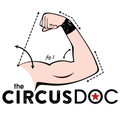This course is for all healthcare professionals who would like to know more about working with aerial artists.
Physical Therapy CEU Credit Available (other continuing education credit may be available. Please enquire) PT, OT, MD, DO, NP, ND, DC, ATC are all welcome
In this continuing education course for healthcare professionals, we will look at the bio-mechanics of the shoulder related to this unique population of athletes through a Movement Systems perspective. During the course we will review and analyze common movements that circus performers perform from hanging and handstands to pull ups, inversions, and skin the cats. With each we will learn to recognize compensatory patterns and risks for injury. You will learn how to enhance your connection to these patients through knowledge of basic vocabulary and observing circus artists in action.
Course Objectives
- Participants will understand the circus artist as an athlete and how to engage and enhance credibility with this population.
- Participants will understand the biomechanics of the shoulder when it is moving into an overhead position and with hanging.
- Participants will learn common patterns of posture, movement, and injury in hanging athletes/aerialists.
- Participants will be able to recognize movement dysfunctions of the scapula and humerus in a hanging athlete/ aerialist.
- Participants will observe circus aerialists and learn about equipment, names of common skills, and learn to speak some of the language of a circus artist.
- Participants will learn corrective exercises for common movement pattern dysfunctions in aerialists and how to cue them for patient success.
Course Outline
Circus Artist as an Athlete and a Patient (9 – 9:30 am)
- History and growth of circus in the US
- Demographics of participants—Enhancing credibility
- Taking a history from a circus performer
Common Injuries and Contributing Factors (9:30 – 10 am)
- Overview of injury epidemiology in current literature and clinical experience
- Hypermobility and the circus artist
Anatomy and Biomechanics (10 am – 12 pm)
- Anatomy and biomechanics of the shoulder girdle with a review of normal shoulder biomechanics and alignment in standing and with shoulder flexion
- Hanging shoulder biomechanics in long hang, bent arm hanging and basket position
- Brief review of hip and trunk anatomy with relationship to basic aerial positions of hollow body, C-shape, and arched body.
LUNCH
Equipment and Vocabulary (1 – 2 pm)
- Observing at a circus school
- Familiarization with equipment and skills in practice
Aerial Skills Breakdown (2 – 4 pm)
- Grips used in aerial arts
- Hanging, Climbing, Front Balance, Inversion variations, Skin the Cat
- Recognition of common movement dysfunctions with these aerial skills and how they relate to shoulder biomechanics and movement impairments or compensations
Treatment for Common Aerial Movement Dysfunctions (4 – 6 pm)
- Sample Evaluation demonstration
- Exercises, cues, and patient education for correction of common movement impairments in aerial circus artists
- Practice applying exercises and cuing in lab (max student ratio 16:1)
Early Bird Pricing until 6/1/19!
Cancellation Policy: Refunds are available up to 1 month prior to the course. After that time, enrollments are transferable. Please contact emily@thecircusdoc.com with any changes.
